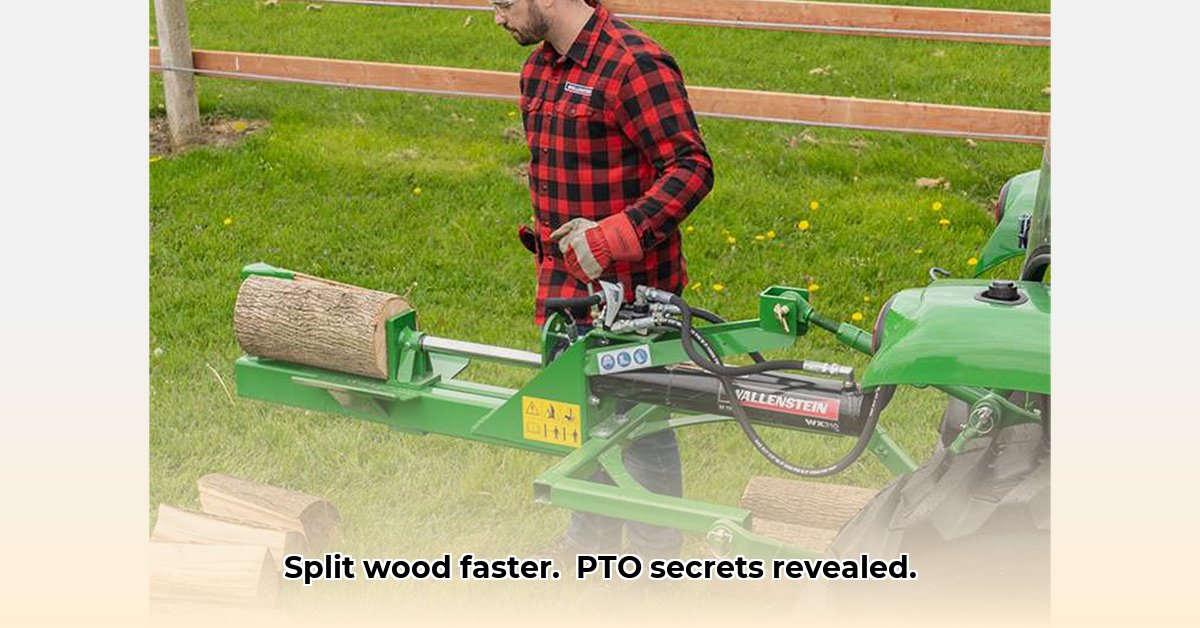
Choosing the right PTO tractor log splitter can significantly improve your firewood production efficiency. This guide will walk you through the decision-making process, helping you select the best model for your needs and ensuring safe operation. For help disconnecting your PTO shaft, see this helpful guide on PTO shaft removal.
Understanding PTO vs. 3-Point Hitch Log Splitters
The first major decision is selecting between a PTO (Power Take-Off) and a 3-point hitch log splitter. Both utilize your tractor's power, but through different mechanisms. A PTO splitter directly connects to your tractor's rotating PTO shaft, offering a direct mechanical power transfer. Think of it as a direct drive system. In contrast, a 3-point hitch splitter uses your tractor's hydraulic system, converting hydraulic pressure into splitting force. This requires a hydraulically powered splitting ram.
Which type is right for you? This depends heavily on your tractor's capabilities. Does your tractor possess a robust PTO system and/or sufficient hydraulic capacity? These are critical questions to address before considering specific models. Choosing the wrong type can lead to inefficiency or even equipment damage.
Assessing Your Tractor's Capabilities: A Crucial First Step
Before exploring log splitter options, consult your tractor's owner's manual. Identify the tractor's horsepower (HP) rating and hydraulic flow rate (GPM – gallons per minute). These figures determine your tractor's power output and workload capacity. This is absolutely critical – do not skip this step! Using a splitter exceeding your tractor's capabilities risks damaging both machines, while an underpowered splitter will be painfully slow and inefficient. A properly matched system is key to maximizing safety and efficiency.
Key Features of a High-Performance PTO Log Splitter
Several features significantly impact a PTO log splitter's ease of use and efficiency. Prioritize the following:
- Robust Construction: Invest in a heavy-duty, durable splitter built to withstand years of rigorous use. A poorly constructed splitter will lead to downtime and frustration.
- Comprehensive Safety Features: Prioritize safety. Look for features like integrated log stops (preventing log ejection), a retracting wedge (minimizes pinch points), and clearly marked control panels.
- Intuitive Operation: Simple, user-friendly controls and clear instructions make for a safer and more enjoyable experience. Complicated controls lead to errors and potential injury.
- Two-Way Splitting Capability: Some models split logs in both directions, increasing speed, particularly with stubborn or knotted wood.
Step-by-Step Guide to Safe PTO Log Splitter Operation
Operating a PTO log splitter correctly ensures both efficiency and safety. Follow these steps meticulously:
- Safety Gear is Mandatory: Always wear safety glasses, heavy-duty gloves, sturdy boots, and hearing protection. This is not optional; your safety is paramount.
- Careful Connection: Connect the PTO shaft to both the splitter and the tractor, following the manufacturer's instructions precisely. Double-check all connections before starting the tractor.
- PTO Engagement: Start the tractor, then carefully engage the PTO according to the manufacturer's specifications.
- Secure Log Placement: Use the log cradle to firmly secure the log before initiating the splitting process. Proper log placement is crucial to prevent accidents.
- Initiate Splitting: Operate the splitter's controls to begin the splitting cycle. Some models offer settings for different wood types (hardwood vs. softwood).
- Safe Removal: Carefully remove the split wood, maintaining a safe distance from all moving parts. Never reach into the splitting area while the machine is operating.
- Disengagement and Shutdown: Once finished, disengage the PTO, disconnect the shaft, and turn off the tractor. Ensure all parts are properly secured before leaving the area.
PTO vs. 3-Point Hitch: A Comparative Overview
The following table summarizes the key differences between PTO and 3-point hitch log splitters:
| Feature | PTO Splitter | 3-Point Hitch Splitter |
|---|---|---|
| Power Source | Tractor's PTO Shaft | Tractor's Hydraulic System |
| Hydraulics | Typically none; simpler mechanics | Relies heavily on tractor hydraulics |
| Initial Cost | Generally lower | Generally higher |
| Maintenance | Simpler | More complex; more hydraulic components |
| Tractor Needs | Requires a robust PTO shaft | Requires sufficient hydraulic capacity |
Remember, safe operation and regular maintenance are crucial for optimal performance and longevity. Regularly inspect your splitter for wear and tear, and adhere strictly to the manufacturer’s instructions.
Choosing the Right Splitter: A Decision Framework
Selecting the best PTO tractor log splitter involves careful consideration of several factors:
- Annual Wood Volume: Estimate your annual firewood needs to determine the splitter’s required capacity.
- Tractor Capacity: Ensure your tractor meets the splitter's power and hydraulic requirements.
- Budget: Balance initial cost with long-term maintenance and fuel expenses.
- Safety Features: Prioritize splitters with comprehensive safety features.
By carefully following this guide and considering these key factors, you can confidently select the PTO tractor log splitter that best suits your needs, ensuring efficient and safe firewood processing for years to come. Remember to research specific models and compare features before making a purchase.